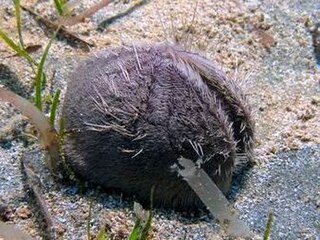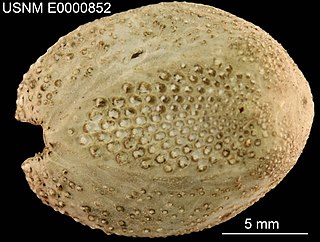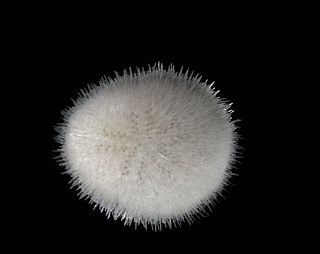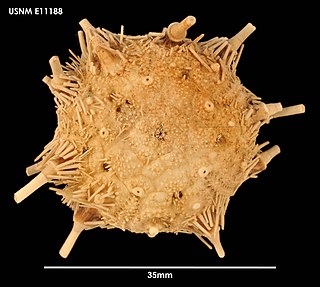
Coelopleurus is an extant genus of echinoids with fossil records dating back to the Eocene, with remains found in Europe and North America.

The heart urchins or Spatangoida are an order of sea urchins.

Cidaridae is a family of sea urchins in the order Cidaroida.

Spatangus is a genus of heart urchins in the Spatangidae family. The genus is synonymous with the previously recognised genera Prospatangus Lambert, 1902 and Spatagus. There are nine recognised species. The type species is Spatangus purpureus Müller, 1776 by subsequent designation.

Maretia is a genus of heart urchins belonging to the family Spatangidae.

Abatus curvidens is a species of sea urchin of the family Schizasteridae. Their armour is covered with spines. It is in the genus Abatus and lives in the sea. Abatus curvidens was first scientifically described in 1836 by Ole Mortensen.

Aceste ovata is a species of sea urchin of the family Schizasteridae. Their armour is covered with spines. It came from the genus Aceste and lives in the sea. Aceste ovata was first scientifically described in 1907 by Alexander Emanuel Agassiz & Hubert Lyman Clark.

Holasteroida is an order of irregular sea urchins.

Eucidaris is a genus of cidaroid sea urchins known as slate pencil urchins. They are characterised by a moderately thick test, a usually monocyclic apical disc, perforate and non-crenulate tubercles and nearly straight ambulacra with horizontal pore pairs. The primary spines are few and widely spaced, stout with blunt flat tips and beaded ornamentation and the secondary spines are short and apressed. They originated in the Miocene and extant members of the genus are found in the tropical Indo-Pacific Ocean, East Pacific, Atlantic Ocean and Caribbean Sea.

Brisaster latifrons is a species of sea urchins of the family Schizasteridae. Their armour is covered with spines. Brisaster latifrons was first scientifically described in 1898 by Alexander Emanuel Agassiz.
Brisaster owstoni is a species of sea urchins of the family Schizasteridae. Their armour is covered with spines. Brisaster owstoni was first scientifically described in 1950 by Ole Theodor Jensen Mortensen.
Brisaster townsendi is a species of sea urchins of the family Schizasteridae. Their armour is covered with spines. Brisaster townsendi was first scientifically described in 1898 by Alexander Emanuel Agassiz.

Chaetodiadema is a genus of sea urchins of the Family Diadematidae. Their armour is covered with spines.

The Neognathostomata are a superorder of sea urchins.

Schizaster is a genus of heart urchins belonging to the family Schizasteridae. The type species of the genus is Schizaster studeri.

Araeosoma is a genus of deep-sea sea urchins in the family Echinothuriidae.

Aporocidaris is a genus of sea urchins in the family Ctenocidaridae. Several species are found in deep water in circum-Antarctic locations.
Palaeostomatidae is a family of echinoderms belonging to the order Spatangoida.

Echinolampas is a genus of echinoderms belonging to the family Echinolampadidae.

Paleopneustina is a suborder of sea urchins of the order Spatangoida. Its taxonomy is still under investigation.
















